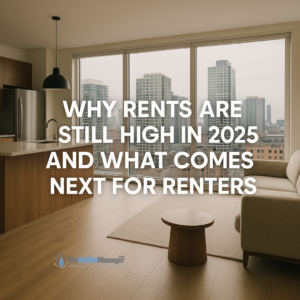Even as new apartments rise across American skylines, millions of renters are still feeling the pinch of sky-high monthly payments. A recent investigative report by USA TODAY (June 12, 2025) dives deep into why rents have remained stubbornly elevated and what it means for renters moving forward.
A New Normal: Rents Still Above Pre-Pandemic Levels
Despite some signs of cooling inflation and increased construction, rents have not returned to pre-pandemic levels in most U.S. cities. According to USA TODAY’s interactive rental tracker, average rent prices are still significantly higher compared to where they were in 2019. In some markets, rents are as much as 20-30% higher than five years ago.
For renters, this means that the affordability crisis that began during the pandemic has not eased instead, it has become the new status quo.
High Home Prices Are Forcing People to Stay Renters
Part of the pressure stems from an overheated housing market. Home prices remain high and borrowing costs have surged with mortgage rates hovering near 7% effectively pricing out many would-be first-time homebuyers. With homeownership out of reach for millions, demand for rental units remains intense.
This “lock-out effect” has forced many households to remain renters far longer than originally planned, keeping vacancy rates low and giving landlords continued leverage to increase rents.
Yes, We’re Building but It’s Not Enough
Over the last few years, multifamily construction has surged to some of its highest levels in decades. Developers have responded to the rental demand with thousands of new units, particularly in major metro areas.
However, this new supply has not been enough to bring meaningful relief, especially in markets that were already severely underbuilt before the pandemic. In many areas, population growth, urban migration, and economic development continue to outpace new construction.
Additionally, much of the new inventory entering the market consists of luxury or high-end apartments, which do little to alleviate the shortage of affordable rental units for working- and middle-class tenants.
Shifting Patterns: Suburbs, Smaller Cities, and Remote Work
Post-pandemic migration patterns have shifted rental demand into suburban areas, smaller cities, and previously overlooked neighborhoods. While these areas were once more affordable alternatives, growing demand has started pushing rents higher here as well.
The rise of remote and hybrid work has also allowed more renters to relocate to desirable markets, intensifying competition for limited inventory across the country from Phoenix to Tampa to the outskirts of major metros.
Rents Are Now a Key Driver of Inflation
The elevated cost of rent is now playing a significant role in keeping inflation elevated. Since housing costs make up a large portion of the Consumer Price Index (CPI), even moderate annual rent increases can continue to ripple through national inflation data.
As the Federal Reserve monitors inflation closely, persistently high rents may prolong interest rate hikes or delays in rate cuts further complicating affordability for both renters and buyers.
What Does the Future Hold?
While some economists predict that rent growth may slow slightly in 2025, few expect a meaningful decline in prices anytime soon. Without significant increases in affordable housing supply or major policy interventions, the rental market is expected to remain tight.
For renters, this means:
-
Budgeting carefully for continued rent increases.
-
Exploring suburban or secondary markets for more affordable options.
-
Keeping an eye on employer remote work policies to expand housing options.
-
Advocating for local and state policies that encourage more affordable housing development.
Bottom Line:
The U.S. rental market remains highly competitive, and for millions of renters, relief is still out of reach. While new units are being built, they haven’t been enough to offset years of undersupply, rising home prices, and growing population shifts. Renters hoping for a meaningful drop in prices may be waiting longer than expected.

